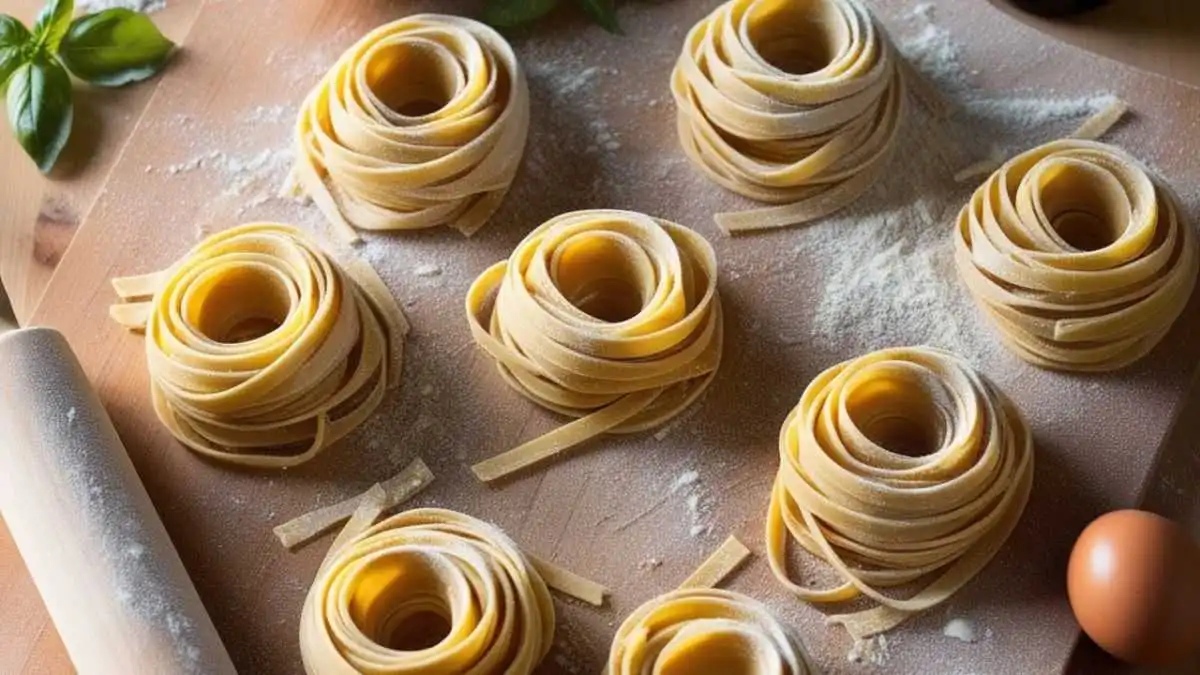Making your pasta is incredibly satisfying. Not only does it taste fresher and tastier than store-bought options, but it also gives you a chance to connect with a timeless culinary tradition. If you’ve ever wondered how to make a basic homemade pasta recipe, you’re in the right place.
This easy beginner’s guide will walk you through every step, from kneading the dough to cooking and storing the pasta. Let’s get started!
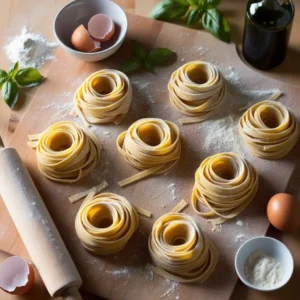
Basic Homemade Pasta Recipe
Equipment
- Clean surface (like a countertop)
- Rolling pin or a pasta machine
- Knife or pasta cutter
- Fork for mixing the dough
- Mixing bowl (optional)
Ingredients
- 2 cups all-purpose flour
- 3 large eggs
- 1 tbsp olive oil
- ½ tsp salt (optional)
Why Make Homemade Pasta?
Before the recipe, let’s discuss why making pasta at home is worthwhile. First, it’s surprisingly easy to make with just a few basic ingredients. Second, the texture and flavor of fresh pasta are unmatched – it’s tender and silky and cooks in just a few minutes.
Finally, making your pasta Is a fun and rewarding experience that will impress your family and friends.
Step-by-Step Guide to Making Homemade Pasta
Step 1. Making the Dough
- First, place the flour on a clean, flat surface or in a large mixing bowl. Make a well in the center of the flour with your hands or a spoon. This well will hold your wet ingredients and prevent them from spilling out.
Step 2. Add the Eggs and Olive Oil
- Crack the egg into the center of the well. If you’re using olive oil and salt, add them now. Use a fork to slowly beat the egg, gradually adding the flour from the sides of the well.
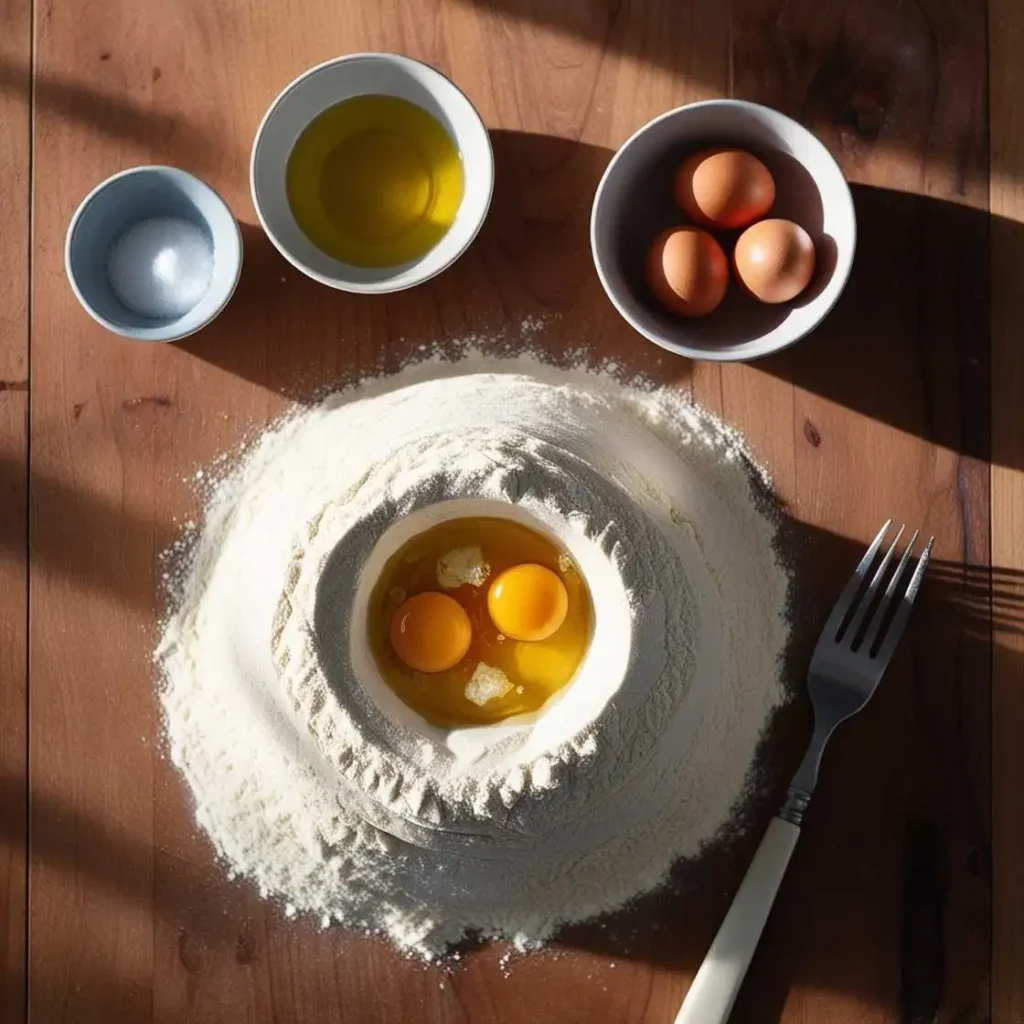
Step 3. Knead the Dough
- When the mixture starts to come together, knead the dough with your hands. Kneading is important for developing the gluten, which gives pasta its structure.
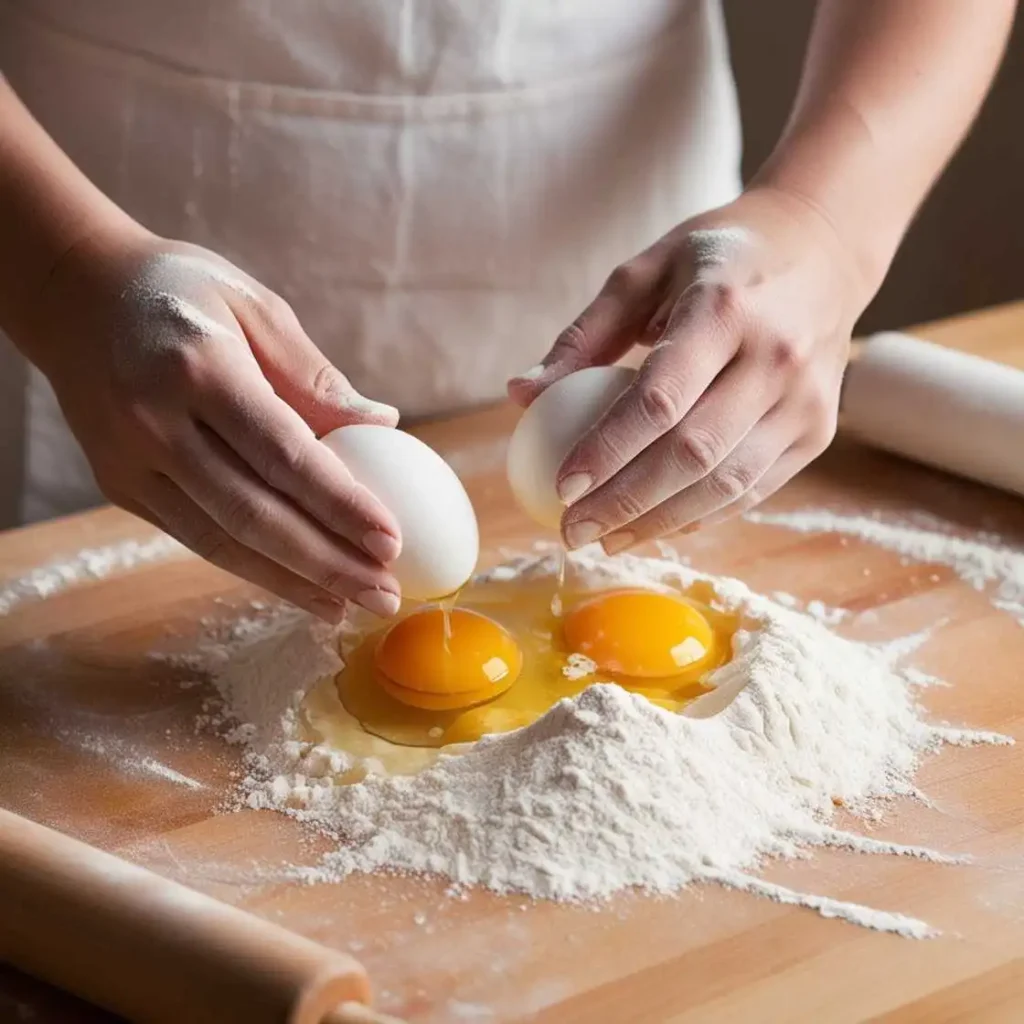
- Knead for about 8-10 minutes until the dough is smooth and elastic. If the dough is too sticky, add a little more flour. If it’s too dry, add a tablespoon of water.
Step 4. Rest the Dough
- Wrap the dough in plastic wrap and let it rest at room temperature for 30 minutes. This relaxes the gluten, making the dough easier to roll out.
Rolling and Shaping Your Pasta
- Divide the Dough: After the dough has rested, divide it into four equal parts. Work with one part at a time, keeping the rest covered to prevent it from drying out.
- Roll Out the Dough: Lightly flour your work surface and rolling pin. Roll out the dough into thin sheets about 1/8 inch thick. If you have a pasta machine, use it to get an even thickness.
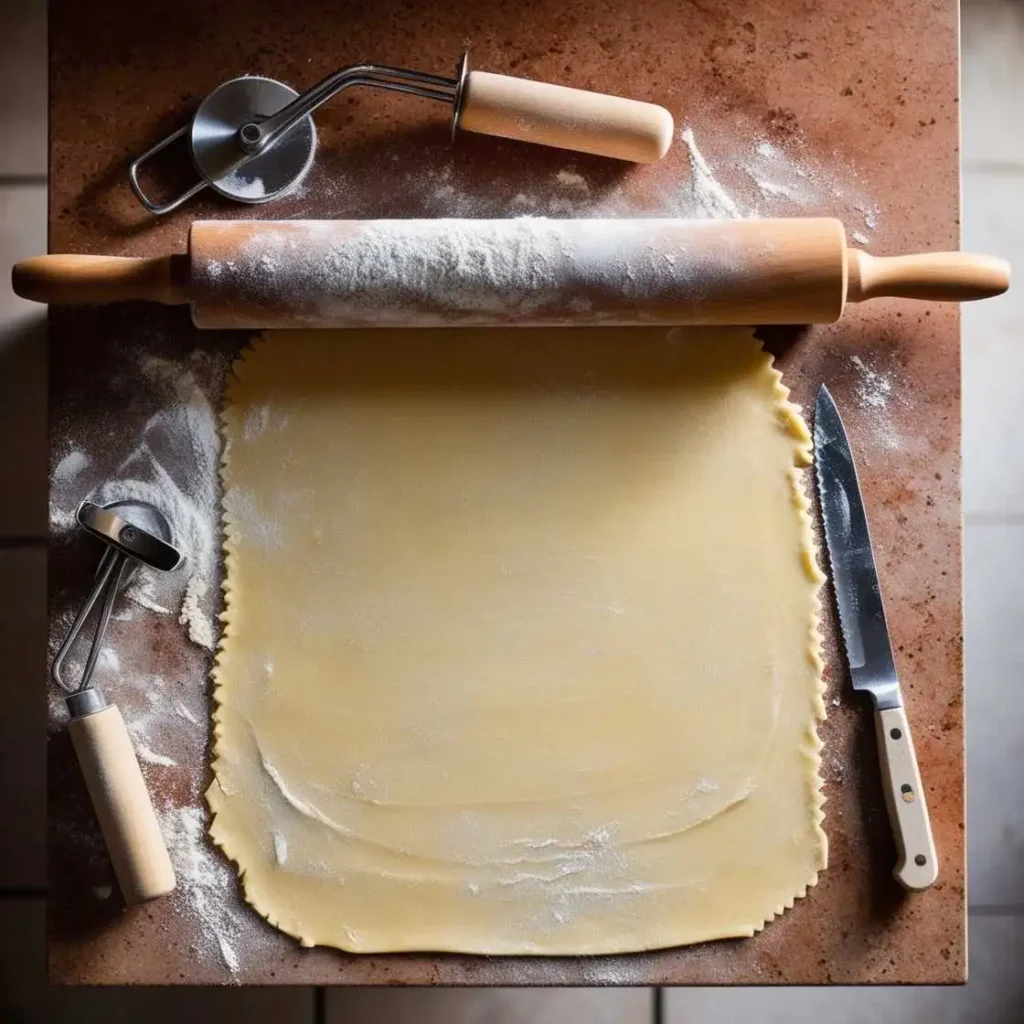
- Cut the Pasta: Now comes the fun part of shaping your pasta! For fettuccine, twist the dough Into a loose roll and cut it into 1/4-inch strips. For tagliatelle, cut slightly wider strips. If you’re making ravioli, cut the dough into squares and add your favorite filling.
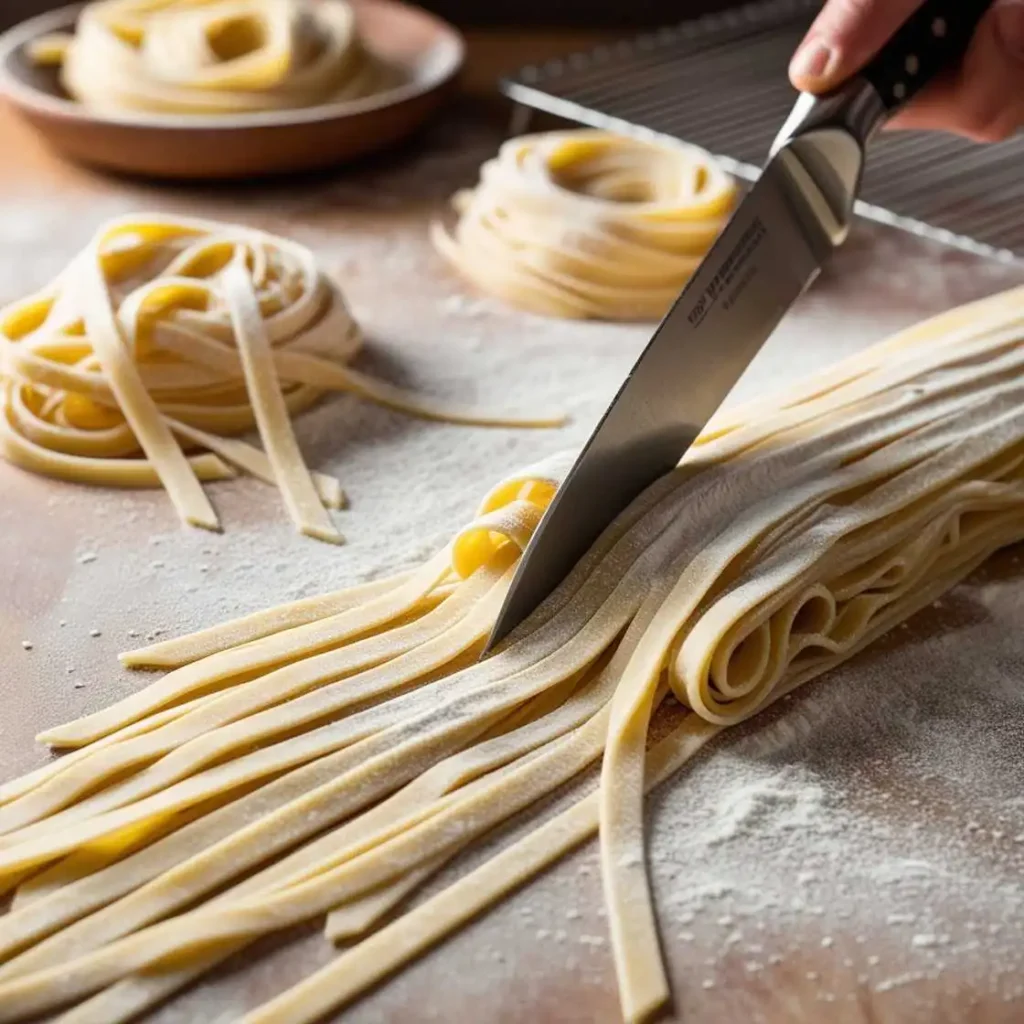
Cooking Your Homemade Pasta
Fresh pasta cooks much more quickly than dried pasta, so keep a close eye on it. Bring a large pot of salted water to a boil, then add the pasta. Cook for 2-4 minutes, or until the pasta floats to the surface and is soft but still slightly firm.
Drain the pasta and toss it with your favorite sauce. Whether it’s a classic marinara, creamy Alfredo, or a simple dressing of garlic and olive oil, your homemade pasta will shine.
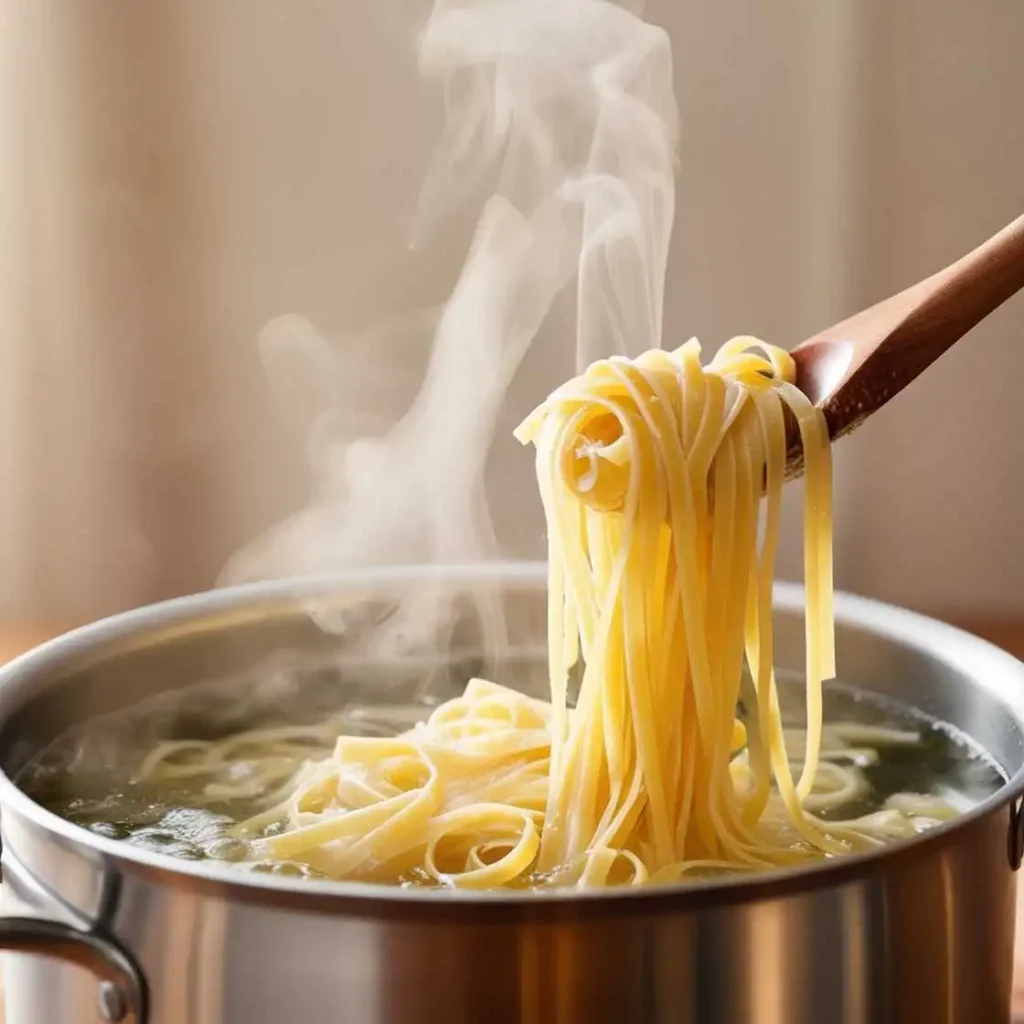
Serving Suggestions for Pasta Homemade Recipe
Once you’ve made your fresh homemade pasta, the next step is serving it in a way that enhances its flavors and texture. Here are some great ways to enjoy your pasta:
Classic Marinara Sauce
- A great addition to homemade pasta, marinara sauce is simple but delicious. Sauté garlic and onion in olive oil, add crushed tomatoes, and season with salt, pepper, and a pinch of sugar to balance the acidity.
- Finish with a sprinkle of fresh basil and Parmesan cheese. This sauce goes great with spaghetti, fettuccine, or any pasta.
Creamy Alfredo Sauce
- For a rich and delicious option, try Creamy Alfredo Sauce. Melt butter in a pan, add heavy cream, and stir in freshly grated Parmesan cheese until smooth.
- Toss your homemade fettuccine or tagliatelle in the sauce, and top with chopped pepper and parsley.
Garlic and Olive Oil
- This minimalist dish lets your homemade pasta shine. Sauté minced garlic in extra virgin olive oil until golden, then toss in your cooked pasta.
- Add a pinch of red pepper flakes and a handful of chopped parsley for a fresh, vibrant finish.
Tips for the Perfect Simple Homemade Pasta
Making pasta at home is a wonderful experience, but even small changes can make a big difference in its texture and taste. Here are some expert tips to ensure your pasta turns out perfect every time!
Use the Right Flour
- 00 flour is best for smooth, delicate pasta.
- Semolina flour creates a firmer texture, ideal for shapes like rigatoni.
- All-purpose flour works too but may need slight adjustments in hydration.
Perfect Dough Consistency
- Your dough should be firm but pliable not too dry or sticky.
- If it’s too dry, add water a tablespoon at a time.
- If it’s too wet, sprinkle in a little more flour.
Cook in Well-Salted Water
- Use plenty of water
- Salt the water generously – it should taste like the sea!
- Fresh pasta cooks much faster than dried pasta (usually 2-4 minutes).
Storing and Freezing Homemade Pasta
If you make more pasta than you can eat at one time, don’t worry. Fresh pasta stores well and can be frozen for later use.
Storing in the Refrigerator
- To store fresh pasta in the refrigerator, lightly sprinkle it with flour to prevent sticking and place it in an airtight container. It will last up to 2 days.
Freezing for Long-Term Storage
- To store longer, freeze the pasta. Place the cut pasta in a single layer on a baking sheet and freeze until solid. Then, transfer it to a freezer-safe bag or container.
- Frozen pasta can last up to 2 months. When you’re ready to cook it, simply add the frozen pasta to boiling water.
Conclusion
Once you try this basic homemade pasta recipe, you’ll never want to go back to store-bought pasta again! It’s fun, rewarding, and a great way to impress your friends and family.
Experiment with different shapes, flavors, and sauces to make it your own. Happy cooking!
Nutrition
Total Fat: 2g | Saturated Fat: 1g | Cholesterol: 60mg | Sodium: 411mg | Total Carbohydrate: 32g | Dietary Fiber: 1g | Total Sugars: 0g | Protein: 6g | Calcium: 15mg | Iron: 2mg | Potassium: 66mg
FAQ
Can I make pasta without eggs?
Yes! You can make eggless pasta using just flour and water. It’s common in certain Italian regions and works well for shapes like orecchiette and cavatelli.
Why is my pasta dough too dry or too sticky?
If your dough is too dry, add a small amount of water. If it’s too sticky, dust it with a little extra flour. The dough should be firm but pliable.
Can I use whole wheat flour instead of regular flour?
Yes, but whole wheat flour absorbs more liquid and makes denser pasta. Try using a mix of whole wheat and all-purpose flour for better texture.
Can I make pasta without a pasta machine?
Absolutely! A rolling pin works just fine for rolling out the dough. It might take a little more effort, but the results will still be delicious.
How do I know when the pasta is cooked?
Fresh pasta cooks in just 2-4 minutes. It’s done when it floats to the surface and is tender but still slightly firm to the bite.

